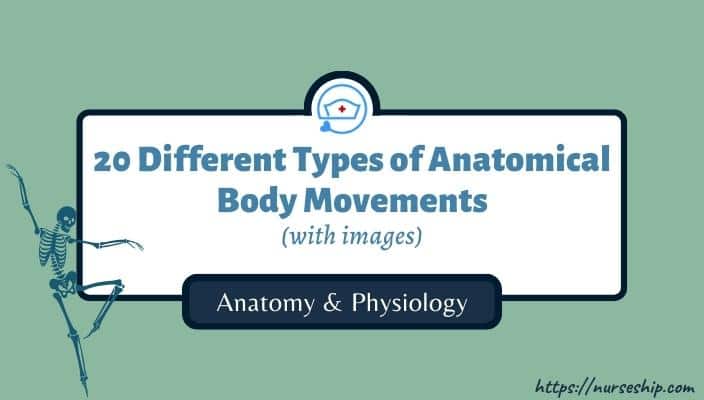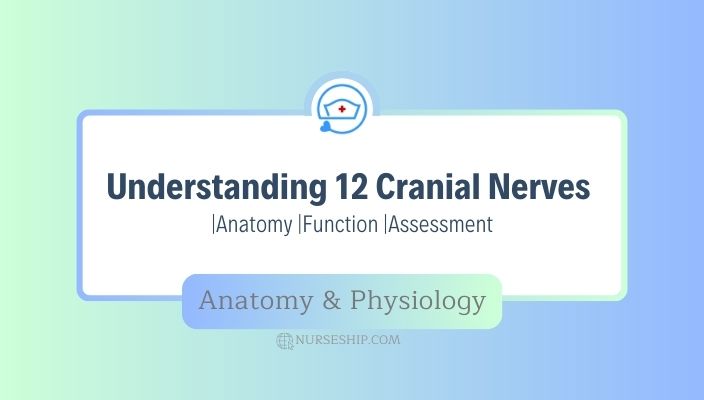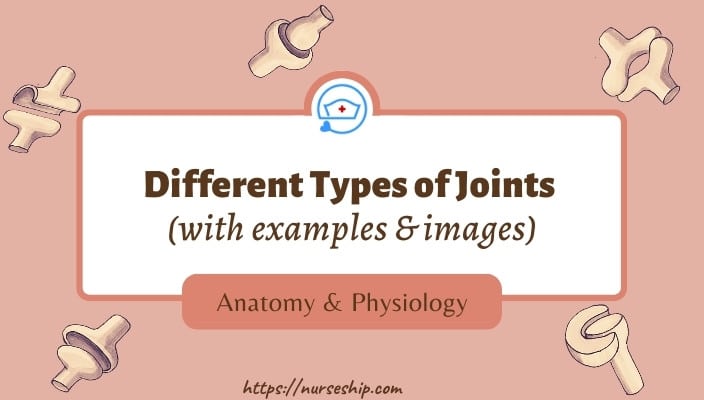20 Different Types of Anatomical Body Movements with Examples & Illustrations
In this post, you will learn about 20 different types of anatomical body movement in humans.
Click here to learn the types of joints in the human body.
The anatomical movements that take place in the human body are also known as the angular movements of the joints.
Below is a list of 20 different types of human anatomical movements.
- Flexion
- Extension
- Abduction
- Adduction
- Rotation
- Circumduction
- Supination
- Pronation
- Inversion
- Eversion
- Dorsiflexion
- Plantar Flexion
- Lateral Flexion
- Hyperextension
- Depression
- Elevation
- Protraction
- Retraction
- Opposition
- Reposition

What is an anatomical body movement?
An anatomical movement involves two bones or body parts moving around fixed joints in relation to the main anatomical axes or planes parallel to them. Such as in the sagittal plane, coronal plane, frontal plane, superiorly, inferiorly, laterally, and so on.

Human Anatomy & Physiology Course
- Guidebooks
- Complete Diagrams & Lessons
- Certifications
- Quiz & Answers
- And More…
Flexion
Flexion decreases the angle between the two bones or two body parts. It results in bending (flexing).
Flexion occurs in the sagittal plane.
Flexion movement is possible at the neck, arm at the shoulder, forearm at the elbow, hand at the wrist, digits, spine, thigh at the hip, and leg at the knee.
Example of flexion:
Following are two examples of flexion.
- Flexing/bending of arms and fingers
- Flexing/bending of elbow and knee
Extension
The extension increases the angle between the bones or two body parts. Straightening (stretching) a body part causes the extension to happen.
Extension and flexion are opposite movements.
Like flexion, the extension also occurs in the sagittal plane.
Extension movement is also possible at the neck, arm at the shoulder, forearm at the elbow, hand at the wrist, digits, spine, thigh at the hip, and leg at the knee.
Example of extension:
Following are two examples of extension.
- Extending/stretching of arms and fingers
- Extending/stretching of elbow and knee

Abduction
Abduction is the movement of a limb or digits laterally away from the midline of the body.
Abduction occurs in the frontal (coronal) plane.
Abduction movement is possible in the arm at the shoulder, digits (fingers), and thigh at the hip.
Example of abduction:
Extending the arm or leg laterally away from the body is an example of abduciton.
Adduction
Adduction is the movement of a limb or digits medially towards the midline of the body.
Abduction is the opposite of adduction movement.
Like abduction, adduction also occurs in the frontal (coronal) plane.
Adduction movement is also possible in the arm at the shoulder, digits (fingers), and thigh at the hip.
Example of adduction:
Bringing the extended arm back to the original position beside the body is an example of adduction.

Circumduction
Circumduction is the circular movement of the joint. It allows the limb to move in a circle (360˚).
Circumduction movement occurs in ball and socket joints such as the hip and shoulders.
Example of circumduction:
The circular movement of the arm at the shoulder is an example of circumduction.
Rotation
Rotation refers to a 180 degree circular movement of joint around the central axis. It can either be:
- Internal (medial) rotation: Rotation of bone towards the body’s midline.
- External (lateral) rotation: Rotation of bone opposite the body’s midline.
The rotation occurs at the head, arm at the shoulder, and thigh at the hip.
Example of rotation:
Turning the head side to side as though to say “no” is an example of rotation.
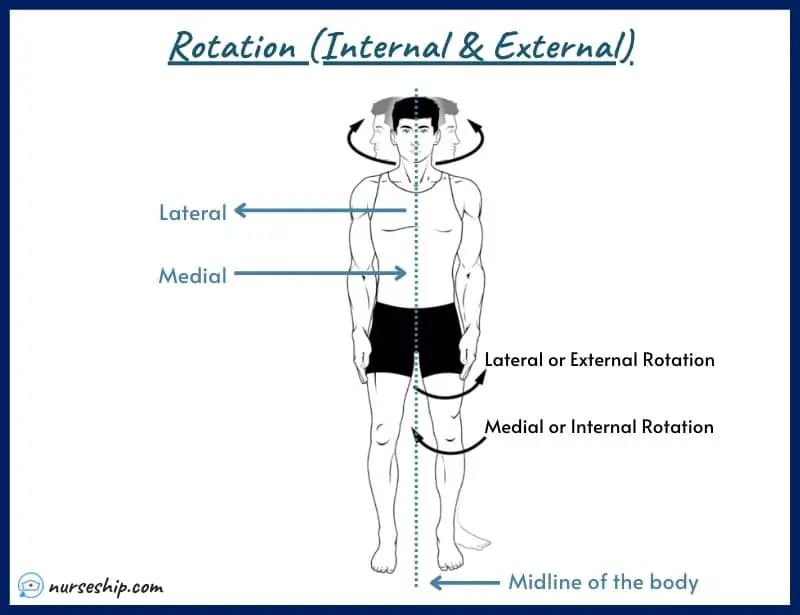
Supination
Supination movement is used to describe the upward orientation of your arm, foot, or palm.
Example of supination:
Supination is the movement of the forearms that causes the palms to face upwards.

Pronation
Pronation movement is used to describe the downward orientation of your arm, foot, or palm.
The opposite of pronation is supination.
Example of pronation:
The act of turning the forearm to face the palm of the hand downward is pronation.
Note: The supination and pronation seem a little complicated when we talk about feet. When referring to the feet, these terms describe how your weight is distributed as you walk or run.
For supination, the weight tends to be more on the outside of your foot when walking.
For Pronation, the weight tends to be more on the inside of your foot.

Inversion
Inversion is the movement of the foot that turns the sole towards the midline.
Example of inversion
The movement of turning the sole medially inward.
Eversion
Eversion is the movement that turns the soles away from the midlines.
Eversion is the opposite movement of inversion.
Example of eversion
The movement of turning the sole laterally outward.

Dorsiflexion
Dorsiflexion is movements of the toes or the foot upwards or towards the sky.
Example of dorsiflexion:
Walking on heels results in dorsiflexion at ankle joints.
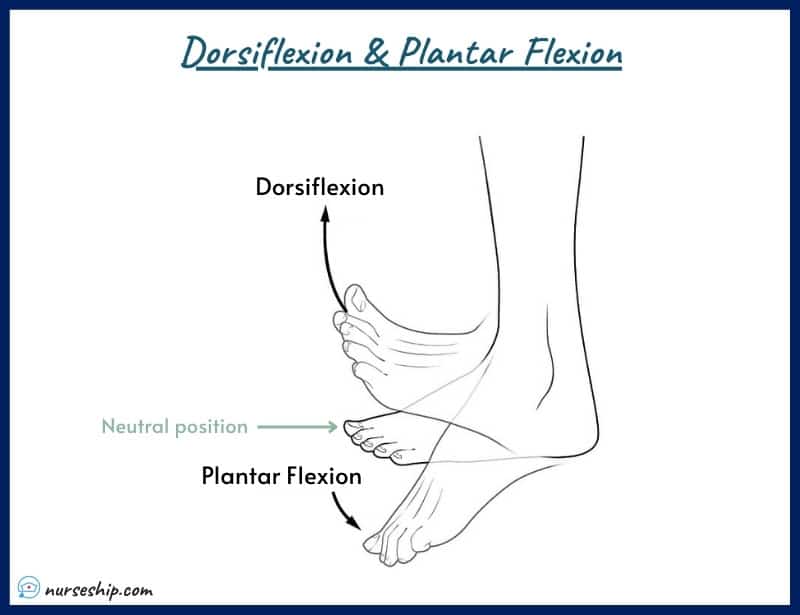
Plantar flexion
Plantar flexion is the movement of toes or feet downwards or towards the ground (plantar surface).
Dorsiflexion and plantar flexion are opposite movements.
Example of plantar flexion:
- Pressing a car pedal results in plantar flexion at the ankle joint
- Standing on tiptoes

Lateral flexion
Lateral flexion is the bending of the spine (vertebral column) either to the left or right side.
Lateral flexion can occur in the trunk at the lumbar and thoracic spine. Also, in the neck at the cervical spine.
Example of lateral flexion
An example of lateral flexion would be bending the trunk of the body laterally to the left side.

Hyperextension
Hyperextension is defined as the movement of a joint beyond its normal range of motion.
Hyperextension (overextension) can cause pain and injuries to the joint and surrounding structures.
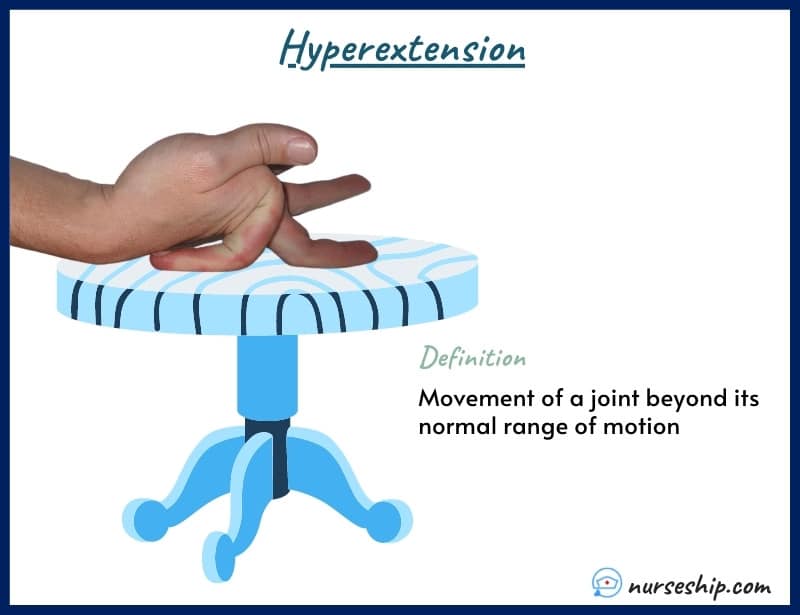
Protraction
Protraction is an anterior-forward movement of a body part.
Protraction can occur at the mandible and scapula.

Retraction
Retraction is a posterior-backward movement of a body part.
Retraction is the opposite of protraction and it also occurs in the scapula and mandible.

Depression
Depression is an inferior-downward movement of a body part.
Depression can occur in the eyelids, mandible, and scapula.

Elevation
Elevation is a superior-upward movement of a body part.
Elevation is the opposite movement of depression. It also happens in the eyelids, mandible, and scapula.

Opposition
Opposition is the movement of the thumb touching the tip of another finger on the same hand.
Opposition occurs in the saddle joint of the thumb.
Reposition
Reposition is the movement of bringing the thumb back to its natural position (i.e., reversal of the opposition movement).

What are the different types of movements in synovial joints?
There are six main types of synovial joints that allow different types of movements in the human body.
The gliding or plane joint, hinge joint, pivot joint, condyloid joint, ball and socket joint, and saddle joint are the six synovial joints.
Examples of the types of movements that can occur at each of these joints are provided in the table below.
| Type of synovial joints | Type of Movements | Examples |
| 1. Gliding joint (Plane joint) | Flexion, extension, inversion, eversion, & lateral flexion of the vertebral column | Movements in facet joints |
| 2. Hinge joint | Flexion & extension | Movements in knee and elbow joints and joints between the phalanges |
| 3. Pivot joint | Rotation only | Movements in the joint between the 1st and 2nd cervical vertebrae (atlas and axis) and joint at the proximal ends of the radius and the ulna |
| 4. Condyloid joint | Flexion, extension, adduction, abduction, & circumduction | Movement of the wrist joint, metacarpophalangeal joints, the joint between the occipital bone of the skull and the first cervical vertebra (atlas) |
| 5. Ball and socket joint | Flexion, extension, adduction, abduction, rotation, & circumduction | Movements in hip and shoulder joints |
| 6. Saddle joint | Flexion, extension, adduction, abduction, rotation, opposition, & reposition | Thumb joint |
Related Articles
Different types of joints in the human body
Male Pelvis vs Female Pelvis Anatomy: What is the difference?
Conclusion
In conclusion, the different types of anatomical movements of the human body include flexion, extension, abduction, adduction, rotation, circumduction, supination, pronation, inversion, eversion, dorsiflexion, plantar flexion, depression, elevation, retraction, protraction, opposition, reposition, lateral flexion, and hyperextension.
Reference
Lippincott Williams & Wilkins. (2009). Anatomy and physiology made incredibly easy! (3rd ed.).
Cohen, B., & Taylor, J. (2009). Memmler’s Structure and Function of the Human Body, 8th ed (10th ed.). Lippincott Williams & Wilkins.
Moini, J. (2020). Anatomy and Physiology for Health Professionals (3rd ed.). Jones & Bartlett Learning, LLC.
Moore, K., Dalley, A., & Agur, A. (2018). Clinically Oriented Anatomy (8th ed.). 8 Wolters Kluwer.
Standring, S., Anand, N., Birch, R., Collins, P., Crossman, A., & Gleeson, M. et al. (2016). Gray’s Anatomy: The Anatomical Basis of Clinical Practice (41st ed.). Elsevier Limited.
Thompson, G. (2015). Understanding Anatomy & Physiology: A visual, auditory, interactive approach (2nd ed.). F. A. Davis Company.

